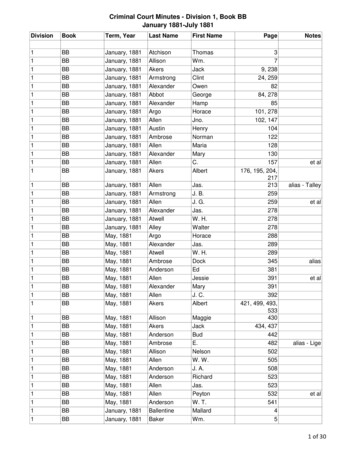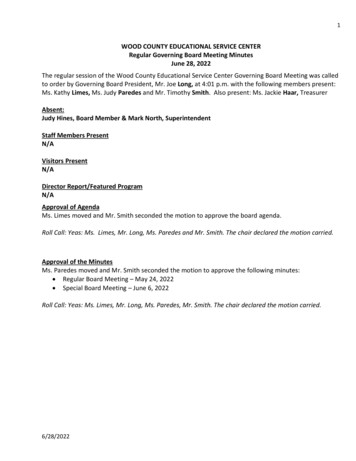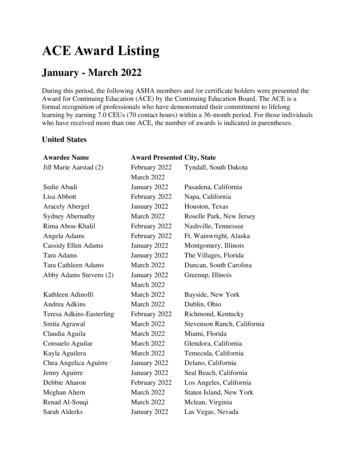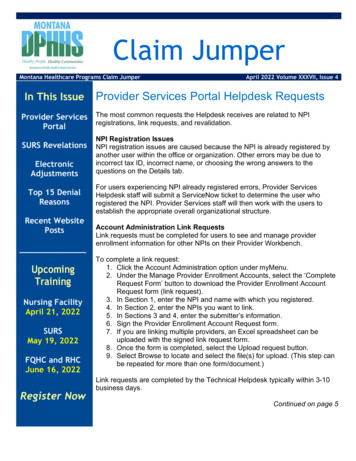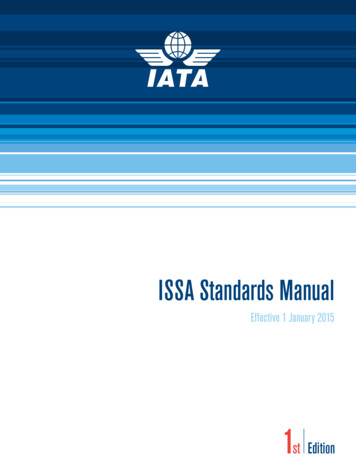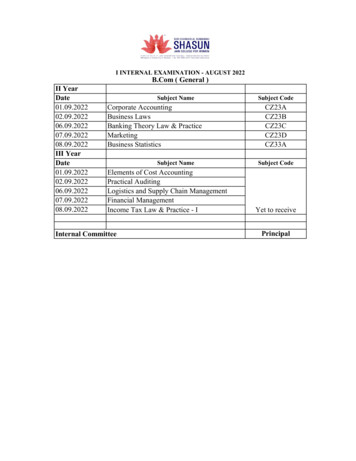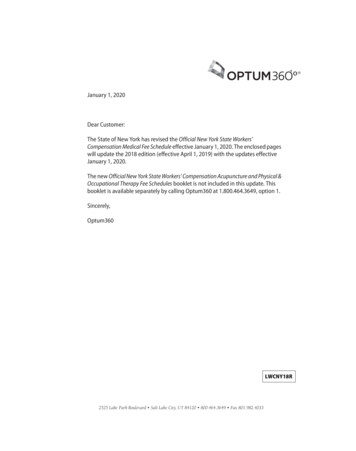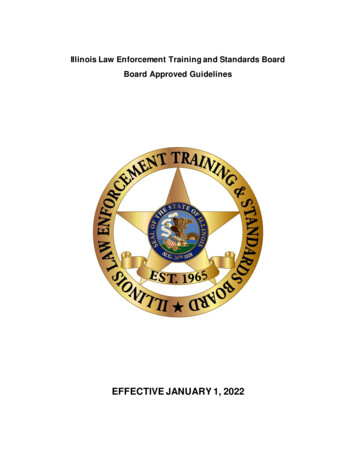
Transcription
Illinois Law Enforcement Training and Standards BoardBoard Approved GuidelinesEFFECTIVE JANUARY 1, 2022
When determining minimum in-service training requirements that a police officer mustsatisfactorily complete, only Board Certified courses that comply with Board approvedguidelines will be considered. These Guidelines are in compliance with state laws effectiveJanuary 1, 2022.Board Policy Adopted September 9, 20212
ContentsKey Civil Rights Guidelines .4Key Constitutional and Proper Use of Law Enforcement Authority Guidelines 5Key Crisis Intervention Training Guidelines 6Key Cultural Competency (including implicit bias and racial/ethnic sensitivity) Guidelines.7Key Emergency Medical Response Training and Certification Guidelines . . .8Lead Homicide Investigator In-Service Training Requirements . . .10Key Human Rights Guidelines . 11Key Law Update Guidelines . 12Key Officer Wellness and Mental Health Guidelines . . 13Key Procedural Justice Guidelines . . . 14Key Psychology of Domestic Violence Guidelines . 15Key Reporting Child Abuse and Neglect Guidelines 16Sexual Assault/Abuse Investigator Training Guidelines . 17Key Sexual Assault/Abuse Trauma-Informed Response Training Guidelines . 18Key Use of Force Guidelines . 193
Key Civil Rights GuidelinesIn order to assist law enforcement agencies in accessing the widest possible variety of in-servicemandated Civil Rights Training (P.A. 99-352), the Training Board has outlined the types of in-servicetraining that would meet the mandate.Any certified training course that contains any of the following Civil Rights Guidelines would beeligible to comply with the mandate: Constitutional RightsFreedom of AssemblyCrowd ControlSearch & SeizurePowers of ArrestProbable CauseRights of HomeownersRights of Vehicle OccupantsWarrantsSelf-IncriminationRequired Warnings to SuspectsInterview and InterrogationRight to CounselCruel and Unusual PunishmentExcessive Use of Force Civil LiabilityUnreasonable Use of ForceFalse ArrestIllegal SearchesLocal Governmental Tort Immunity42 U.S.C Section 1983 ActionsPre-Trial Publicity – Protecting the Rights of the Accused Criminal LiabilityOfficial MisconductProhibited Use of ForceFederal Civil RightsConcealment of Exculpatory Information4
Key Constitutional and Proper Use of Law Enforcement AuthorityGuidelinesIn order to assist law enforcement agencies in accessing the widest possible variety of in-servicemandated Constitutional and Proper Use of Law Enforcement Authority Training (P.A. 99-352), theTraining Board has outlined the types of in-service training that would meet the mandate.Any certified training course that contains any of the following Constitutional and Proper Use ofLaw Enforcement Authority Guidelines would be eligible to comply with the mandate: U.S. Constitution’s relevance to policing in today’s societyAmendments impacting criminal procedureSupreme Court cases that guide police policy, procedure and behavior Constitutional RightsFreedom of AssemblyCrowd ControlSearch & SeizurePowers of ArrestProbable CauseRights of HomeownersRights of Vehicle OccupantsWarrantsSelf-IncriminationRequired Warnings to SuspectsInterview and InterrogationRight to CounselCruel and Unusual PunishmentExcessive Use of Force Limitations of Law Enforcement AuthorityFruit of the Poisonous Tree DoctrineExclusionary RuleJurisdictional IssuesCivil LiabilityUnreasonable Use of ForceFalse ArrestIllegal SearchesLocal Governmental Tort Immunity42 U.S.C Section 1983 ActionsPre-Trial Publicity – Protecting the Rights of the Accused5
Key Crisis Intervention Training GuidelinesIn order to assist law enforcement agencies in accessing the widest possible variety of in-servicemandated Crisis Intervention Training (P.A. 101-652), the Training Board has outlined the types of inservice training that would meet the mandate.Any certified training course that contains any of the following Crisis Intervention TrainingGuidelines would be eligible to comply with the mandate: History of Mental HealthCausesSigns & SymptomsADA & Other Mental Health LawsMental Health and Developmental Disability Code Types of Mental IllnessAnxiety DisordersPost-Traumatic Stress DisorderDepressionPsychotic DisordersSchizophreniaAddictionsBipolar DisorderPersonality DisordersAlzheimer’s & DementiaAutism & Developmental Disabilities De-escalation Techniques Crisis InterventionMental Health Awareness and Response: Introduction to CIT40 hour Crisis Intervention Team TrainingCrisis Recognition rces Police Stress/SuicideCausesOfficer WellnessIntervention6
Key Cultural Competency Guidelines (including implicit bias and racialand ethnic sensitivity)In order to assist law enforcement agencies in accessing the widest possible variety of in-servicemandated Cultural Competency Training (P.A. 99-352 and P.A. 101-0652), the Training Board hasoutlined the types of in-service training that would meet the mandate.Pursuant to P.A. 101-0652, any certified Cultural Competency training MUST contain training onimplicit bias and racial and ethnic sensitivity.In addition to training specifically covering implicit bias and racial and ethnic sensitivity, acertified Cultural Competency training course may also contain any of the following additional CulturalCompetency Guidelines and would be eligible to comply with the mandate: Supervisory Cultural CompetencyHow Changing Demographics Affect Police ServicesUnderstanding Cultural Differences within your AgencyElimination of Discriminatory PracticesUnderstanding Generational Differences First Responder Cultural CompetencyLanguage SkillsNon-verbal Communication of Different CulturesLGBTQ AwarenessUnderstanding Community PerceptionImplicit BiasCultural Conflict Recognition Community PolicingOvercoming Bias Against PoliceBuilding Trust and Legitimacy within Diverse CommunitiesProblem Solving – Bridging Gaps Between Police and CommunityHistory of Racial ProfilingStop Cards7
Key Emergency Medical Response Training and Certification GuidelinesIn order to assist law enforcement agencies in accessing the widest possible variety of in-servicemandated Emergency Medical Response Training and Certification (P.A. 101-652), the Training Boardhas outlined the types of in-service training that would meet the mandate.Any certified training course that contains a hands on, performance based skills check of theparticular skills covered in the course of any of the following Emergency Medical Response Training andCertification Guidelines would be eligible to comply with the mandate: How to recognize an emergency and size up the scene Activate and work with the emergency medical services (EMS) system Legal concepts and considerationsFor lay responders, including consent and the purpose of Good Samaritan lawsApplied to situations that a professional rescuer might encounter Standard precautions to take to prevent disease transmission when providing care How to check a person who is responsive for life-threatening and non-life-threateningconditions How to check an injured or ill person who appears to be unresponsive Signs and symptoms of a heart attack, and describe appropriate first aid care for a person who isshowing these signs and symptomsLinks in the Cardiac Chain of SurvivalCPR and use of an automated external defibrillator (AED) for a person who is in cardiacarrest First aid care for a person who is choking Signs and symptoms of shock, and appropriate first aid care for a person who is showing thesesigns and symptoms Signs and symptoms of, and appropriate first aid care for, the following sudden illnesses:breathing emergencies, diabetic emergencies, seizures, fainting and stroke How to safely and effectively give ventilations (how to safely and effectively use a bag-valvemask (BVM) resuscitator with two rescuers)8
Methods used to control external bleeding, including the application of direct pressure and theapplication of a commercial tourniquetApplication of direct pressure to control external bleedingApplication of wound packing to control external bleedingUse of a commercial tourniquet and the basic principles of using a tourniquetApplication of a tourniquet (commercial and/or improvised) to control external bleeding Signs and symptoms of, and appropriate first aid care for, the following injuries: burns; muscle,bone and joint injuries; and head, neck and spinal injuries (including concussion) Signs and symptoms of, and appropriate first aid care for, the following environmental injuriesand illnesses: heat-related illnesses, cold-related illnesses and poisoning Recognizing anaphylaxisDifferentiate between a mild allergic and a severe (anaphylactic) reactionApplication of the emergency action steps to an anaphylaxis emergency Steps for administering and demonstrate how to use an epinephrine auto-injectorMaintaining an epinephrine auto-injector Strategies for treating wounded responders in threatening environments Techniques for dragging and carrying victims to safety9
Key Lead Homicide Investigator In-Service Training Renewal GuidelinesIn order to assist law enforcement agencies in accessing the widest possible variety of 32 hoursof in-service training (20 Ill. Adm. Code 1720.350), the Training Board has outlined the types of in-servicetraining that would meet the requirement. Death/Homicide Investigative TechniquesFrom basic homicide investigator course to advanced investigative techniques Types of DeathFrom legal definitions to coroner/medical examiner “manner of death” Specific Death/Homicide InvestigationsFrom traffic accidents to child death to domestically related homicides, etc. Crime ProfilingFrom victim profiling, VICAP, offender profiling to crime analysis, etc. Crime Scene ManagementFrom securing the scene to documentation to processing, etc. Legal issuesFrom evidence collection to warrants to interviews, etc. Interview & InterrogationFrom basic skills to death notification to ERHI/Miranda, etc. Investigative ResourcesFrom basic records to crime analysis to social media Investigative PartnershipsFrom coroners to task forces to media relations Case Supervision/Management/Court PreparationFrom documentation to case preparation to testimony, etc. Victims’ RightsFrom initial contact to family to notifications Ethical/Confidentiality IssuesFrom security of evidence and case files to texts/photos/social media, etc.10
Key Human Rights GuidelinesIn order to assist law enforcement agencies in accessing the widest possible variety of in-servicemandated Human Rights Training (P.A. 99-352), the Training Board has outlined the types of in-servicetraining that would meet the mandate.Any certified training course that contains any of the following Human Rights Guidelines wouldbe eligible to comply with the mandate: Illinois Human Rights ActProtecting Personal DignityMental Health InterventionAgency Recruitment/Hiring PoliciesProtecting Those with DisabilitiesCrises Intervention Domestic ViolenceOrders of ProtectionPropensity Evidence Sex CrimesHuman TraffickingSexual AssaultSexual AbusePropensity EvidenceAgency Harassment Policies Hate CrimesRights of LGBTViolence based on Race or ReligionViolence based upon NationalityVerbal Communication Skills in Foreign Languages Crimes Against the ElderlyElder AbuseFinancial Exploitation Crimes Against ChildrenChild PornographyChild ExploitationMissing ChildrenChild Abuse11
Key Law Update GuidelinesIn order to assist law enforcement agencies in accessing the widest possible variety of in-servicemandated Law Update Training (P.A. 99-352), the Training Board has outlined the types of in-servicetraining that would meet the mandate.Any certified training course that contains any of the following Law Update Guidelines would beeligible to comply with the mandate: Recent Illinois Statutes that affect law enforcementAdditions to the Illinois Criminal CodeAdditions to the Illinois Vehicle CodeChanges to the Juvenile LawPolice Community Relations Improvement ActConcealed Carry FirearmsThe Rights of Crime Victims and Witnesses ActChanges to Domestic Violence ActSexual Assault Incident Procedure ActThe Rights of Crime Victims and Witnesses Act Recent Federal Statutes that affect law enforcement.Changes to Federal Administrative Rules Recent Federal or State Case law decided that affects law enforcementConstitutional IssuesSearch and SeizureExclusionary RulesRight to Counsel Procedural and substantive legal issues important to patrol officers and investigatorsInterviews and InterrogationsIdentification ProceduresPropensity EvidenceCivil Liability and Qualified Immunity Recent Federal or State Case law decided that affects law enforcementSearch and SeizureExclusionary RulesRight to Counsel Impaired & Distracted DrivingMedical MarijuanaSFST RefresherAdvanced Roadside Impaired Driving EnforcementDrug Recognition12
Key Officer Wellness and Mental Health GuidelinesIn order to assist law enforcement agencies in accessing the widest possible variety of in-servicemandated Officer Wellness and Mental Health Training (P.A. 101-0215 and P.A. 101-0652), the TrainingBoard has outlined the types of in-service training that would meet the mandate.Any certified training course that contains any of the following Officer Wellness and MentalHealth Guidelines would be eligible to comply with the mandate: Mental Health and Suicide PreventionJob Related Stress Management TechniquesRecognizing Signs and Symptoms of Work-Related Cumulative StressRecognition of Other Issues That May Lead to Officer SuicideSolutions for InterventionPeer Support Resources Financial WellnessUnderstanding Personal FinancesGuidance with Financial DecisionsUnderstanding Savings & InvestmentsRetirement PlanningProtecting the Financial Needs of Family Members Physical Health and FitnessBuilding Departmental Fitness ProgramsFitness Training ProgramsProper NutritionDisease PreventionImportance of Sleep, Hydration, and Supplementation13
Key Procedural Justice GuidelinesIn order to assist law enforcement agencies in accessing the widest possible variety of in-servicemandated Procedural Justice Training (P.A. 99-352), the Training Board has outlined the types of inservice training that would meet the mandate.Any certified training course that contains any of the following Procedural Justice Guidelineswould be eligible to comply with the mandate: Supervisory Procedural Justice – Fairness and ConsistencyLeadership DevelopmentEffective SupervisionOrganizational Policy and OversiteOfficer Wellness & SafetyRecruiting to reflect community diversity First Responder Procedural Justice – ImpartialityReasonable Use of ForceDe-escalation TrainingCrisis Intervention Team TrainingVerbal and Non-verbal communicationBias AwarenessLanguage and Cultural ResponsivenessTrauma and Victim ServicesDisease of Addiction Community Relationships – Voice & TransparencyProblem Oriented PolicingTechnology and Social MediaNeighborhood Crime AnalysisPublic DialogDispute ResolutionPublic PerceptionBuilding Trust and Legitimacy14
Key Psychology of Domestic Violence Training GuidelinesIn order to assist law enforcement agencies in accessing the widest possible variety of in-servicemandated Psychology of Domestic Violence Training (P.A. 99-810), the Training Board has outlined thetypes of in-service training that would meet the mandate.Any Certified training course that contains any of the following Psychology of Domestic Violencewould be eligible to comply with the mandate:Actions of Domestic Violence AbusersActions of Domestic Violence VictimsDomestic Violence Case StudiesDomestic Violence ProtocolsDynamics of Aggressor –Victim RelationshipsEvaluation claims where both parties claim to be victimsIllinois Statutes related to domestic violence including but not limited to evidence of other domesticviolence crimes 725 ILCS 5/115-7.4Impact of police failure to respond to domestic violenceImpact of police response to domestic violenceInterpretation of injuriesLong term effects of domestic violenceNo stalking contact ordersOffender manipulationOrders of protectionOutside resourcesPhysical and psychological impact of domestic violencePower and controlPrevention techniques to stop further victimizationPsychology of domestic violenceRole of advocatesStalking behaviorDomestic Violence Victim centered investigations15
Key Reporting Child Abuse and Neglect GuidelinesIn order to assist law enforcement agencies in accessing the widest possible variety of in-servicemandated Reporting Child Abuse and Neglect Training (P.A. 101-564), the Training Board has outlinedthe types of in-service training that would meet the mandate.Any certified training course that contains any of the following Reporting Child Abuse andNeglect Guidelines would be eligible to comply with the mandate: Abused and Neglected Child Reporting ActTerms & DefinitionsPolicies and Procedures for investigatingAbuseEndangermentNeglect Juvenile Court ActTaking into CustodyDuties of an OfficerNotification of Department of Children and Family ServicesMandated ReportersIllinois Child Abuse Hotline Abduction and AMBER AlertKidnappingHuman TraffickingUnlawful RestraintChild AbductionLuring of a Minor16
Key Sexual Assault/Abuse Investigator Training GuidelinesP.A. 99-0801 amended the Police Training Act and mandated training for all officers andinvestigators in trauma-informed responses to investigations of sexual assault and sexual abuse crimes.In order to assist law enforcement agencies in accessing in-service Sexual Assault/Abuse InvestigatorTraining, the training MUST include, but is not limited to, the following:Responding officer dutiesDuties of officer investigating sexual assault/abuseSupervisor’s dutiesReport writingReporting methodsTrauma-Informed interviewing techniquesEvidence Collection (including, but not limited to physical, medical, and computer/electronics)Sexual Assault medical forensic examinationsOffender characteristicsSuspect interviewsSuspect forensic examsWitness interviewsWorking with victim advocatesWorking with prosecutorsVictims’ rightsVictim notificationConsideration for specific populations or communitiesApplicable Illinois sexual assault/abuse lawsAny Certified training course that contains all of the above would be eligible to comply with themandate. Note, Sexual Assault/Abuse Investigators MUST also attend the Sexual Assault/AbuseTrauma-Informed Response Training.17
Key Sexual Assault/Abuse Trauma-Informed Response TrainingGuidelinesP.A. 99-0801 amended the Police Training Act and mandated training for all officers andinvestigators in trauma-informed responses to investigations of sexual assault and sexual abuse crimes.In order to assist law enforcement agencies in accessing in-service Sexual Assault/Abuse TraumaInformed Response Training, the training MUST include, but is not limited to, the following:Recognizing the symptoms of TraumaUnderstanding the role trauma has played in the victim’s lifeResponding to the needs and concerns of a victimDelivering services in a compassionate, sensitive, and nonjudgmental mannerTrauma-Informed interviewing techniquesUnderstanding cultural perceptions and common myths of sexual assault/abuseResponding officer dutiesReport writingRecognizing special sensitivities of victims due to: age, including those under the age of 13; gender;or other qualifications (P.A. 100-910)Applicable Illinois sexual assault/abuse lawsAny Certified training course that contains all of the above would be eligible to comply with themandate.18
Key Use of Force GuidelinesIn order to assist law enforcement agencies in accessing the widest possible variety of in-servicemandated Use of Force Training, the Training Board has outlined the types of in-service training thatwould meet the requirement. Officers shall complete 30 hours of training every 3 years, includingtraining in Use of Force. The Use of Force Training shall include:-at least 12 hours of hands-on, scenario-based role-playing-at least 6 hours of instruction on use of force techniques, including the use of de-escalationtechniques to prevent or reduce the need for force whenever safe and feasible-at least 6 hours of training focused on high-risk traffic stops-specific training on the law concerning stops, searches, and the use of force under the 4 thAmendment of the US Constitution (including knowledge of policies and laws regulating theuse of force)-specific training on officer safety techniques, including cover, concealment, and timeAny certified training course that contains any of the following Use of Force Guidelines would beeligible to comply with the mandate: Use of Force Law course--the course must include:Illinois Use of Force Laws 720 ILCS 5/7 et. Seq.5/7-1 Defense of Person5/7-2 Defense of Dwelling5/7-3 Defense of Other Property5/7-4 When the justified Use of Force in 7-1, 7-2, and 7-3 is Not Available5/7-5 In Making an Arrest (Peace Officer)5/7-5.5 Prohibited Use of Force by Peace Officer5/7-6 Private Person in Making an Arrest5/7-8 What is Deadly Force5/7-9 Prevention of Escape5/7-15 Duty to Render Aid5/7-16 Duty to InterveneProtections of the U.S. Constitution (specifically the 4th and 8th Amendments)Reasonable Use of Force (both at time of the arrest and once arrestee is in custody)Due ProcessInvestigative (Terry) StopsSearch warrantsEthical IssuesExcessive Use of ForceCivil Liability High-Risk Traffic Stops course—at least 6 hours and the course must include:Traffic Stop considerationsVehicle TacticsOfficer safety techniques (including cover/concealment utilization)19
Use of Force/De-Escalation Techniques course—at least 6 hoursLethal and Non-Lethal ForceActive ShooterFirearms TrainingOfficer Involved ShootingsSimulation TrainingElectro-Muscular DisruptionOC SprayPPCTConcealed Carry (retired officers and civilians)De-escalation Training20
Pursuant to P.A. 101-0652, any certified Cultural Competency training MUST contain training on implicit bias and racial and ethnic sensitivity. In addition to training specifically covering implicit bias and racial and ethnic sensitivity, a certified Cultural Competency training course may also contain any of the following additional Cultural
